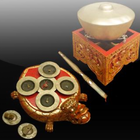Gong Kebyar1.36


Rating

Genre
GAMES

Size
27.1 MB
Version
1.36
Update
Jul 12 2024
Gong Kebyar APK for Android. Download now!
 Download
Download
Gong Kebyar Bali Indonesian Gamelan Music Instruments
Gamelan gong Kebyar the type or types of gamelan music is most commonly available and most often staged in Bali. Physically Gong Kebyar is a simplification of Gong Gede with a reduction in the role or reduction of some fruit instrument. The word literally means Kebyar quickly, suddenly, and hard; reflect the type of gamelan gong Kebyar very dynamic, hard, and has a fast tempo. [3] Gamelan gong Kebyar has five basic tones called barrel pelog namely: nding, Ndong, ndeng, ndung, and ndang.
Gamelan gong Kebyar as the art of traditional Balinese music in the history of the written chronicle of Bali, gong Kebyar expected to appear in Singaraja in 1915.
Village mention as the origin of the appearance of Gong Kebyar is Jagaraga (Buleleng) who also started the tradition of dance Kebyar.
There is also other information that says that Gong Kebyar first appeared in the village Bungkulan (Buleleng). Art developments Kebyar Gong reaches one peak in 1925 with the arrival of a dancer Jauk named Ketut Mario from Tabanan are creating a dance Kebyar Sit or Kebyar Trompong.
Kebyar Gamelan Gong Gede sourced from,
Sourced from gamelan palegongan.
Pure new artificial.
The first has embat corresponding to embat gamelan gong gede is somewhat lower as numerous in North Bali. a second group embat equal to embat gamelan palegongan (source) that is somewhat high as the most likely in the southern part of Bali, gamelans Kebyar pure new artificial mostly air-embat being as found in various regions of Bali and outside Bali , This fact shows that there is no standardization embat for Kebyar Gamelan in Bali.
Also Named gong Kebyar, according to excerpts ekadarmaputra blog entry in the ISI, Gong Kebyar sounded for the first time caused tremendous shock. People have become stunned and cattle which were tied in the fields and in the cage apart and ran helter-skelter.
Also mentioned in the blog entry, gong Kebyar a wasp together and simultaneously followed by almost all the devices except tungguhan tungguhan on flute, Kajar, fiddle, kempul, bebende kemong, Kajar and Terompong.
Kebyar shape is one part of a whole gending location can be at the front, in the middle or at the end. Kebyar wasp type is often used in dance and percussion accompaniment petegak (instrumental). Therefore Kebyar has the feel of a very dynamic, hard with the hope that with the Kebyar to evoke the spirit.
Structure Gong Kebyar
Gong Kebyar is one device / barungan gambelan Bali consisting of five tones (five tones) with the barrel pelog, but each instrument consists of ten blades.
Gong Kebyar for the Balinese people are already familiar, since almost all villages and hamlets in Bali have one device / barungan Gong Kebyar.
Therefore gong Kebyar become one barungan gambelan relatively new when compared with other types of gambelan that exist today such as, for example, gambelan Xylophone, Gong Gde, slonding, Semara Pegulingan and many others.
Barungan gong Kebyar consists of:
Two (tungguh) pengugal / giying
Four (tungguh) pemade / Gansa
Four (tungguh) Kantilan
Two (tungguh) jublag
Two (tungguh) Penyacah
Two (tungguh) jegoggan
One fruit (tungguh) reong / riyong
One fruit (tungguh) Terompong
One pair of gongs lanang wadon
One fruit kempur
One kemong hanging fruit
One fruit bebende
One fruit kempli
One fruit (pangkon) molasses-syrup ricik
One pair of drum lanang wadon
One fruit Kajar
What's New in the Latest Version 1.36
Last updated on Jul 12, 2024
Minor bug fixes and improvements. Install or update to the newest version to check it out!
Gong Kebyar: A Captivating Ensemble of Balinese PercussionGong Kebyar, an enchanting form of Balinese music, captivates listeners with its vibrant and complex rhythms, intricate melodies, and mesmerizing gong sounds. Originating from the village of Banjar Kelod in the Gianyar regency, this captivating ensemble has become an integral part of Balinese cultural and religious ceremonies.
Instrumentation and Structure
A Gong Kebyar ensemble typically comprises around 20 to 30 musicians, each playing a specific instrument. The core instruments include:
* Gong Agung: A large, suspended gong that provides the rhythmic foundation.
* Gong Wadon: A smaller gong that plays a countermelody to the Gong Agung.
* Ceng-Ceng: A set of small cymbals played with a rapid, intricate technique.
* Reyong: A metallophone with 12 to 14 keys that plays the main melody.
* Gambang: A xylophone with 18 to 20 keys that provides a rhythmic accompaniment.
* Suling: A bamboo flute that plays ornamental melodies and improvisations.
Rhythmic Complexity
The rhythmic structure of Gong Kebyar is highly complex, featuring intricate patterns that interlock and overlap. The Gong Agung establishes the primary rhythm, while the other instruments play around it, creating a captivating interplay of sounds. The tempo of the music varies throughout the performance, from slow and meditative to fast and exhilarating.
Melodic Intricacies
The melodies in Gong Kebyar are equally complex, with intricate motifs and variations played by the Reyong and Suling. The musicians improvise within a set framework, creating unique and captivating interpretations. The melodies often explore traditional Balinese scales and modes, adding to the music's exotic and enchanting character.
Performance Practices
Gong Kebyar is typically performed in a sitting position, with the musicians arranged in a semi-circle. The performance begins with a slow and meditative section known as the "Pembukaan," which gradually builds in tempo and intensity. As the music progresses, the rhythms become more complex and the melodies more elaborate.
Cultural Significance
Gong Kebyar holds a deep cultural significance in Bali, where it is often performed at temple ceremonies, weddings, and other important events. The music is believed to have spiritual and purifying powers, and it is often used to accompany traditional dance performances.
Contemporary Adaptations
In recent years, Gong Kebyar has gained international recognition and has been incorporated into contemporary musical compositions and performances. The ensemble's unique and captivating sound has inspired musicians from various genres to explore its possibilities, leading to innovative and cross-cultural collaborations.
Conclusion
Gong Kebyar, with its mesmerizing rhythms, intricate melodies, and enchanting gong sounds, is a testament to the rich musical traditions of Bali. This captivating ensemble continues to captivate audiences around the world, showcasing the beauty and complexity of Indonesian music.
1 / 5 ( 451 votes )









